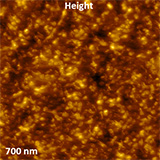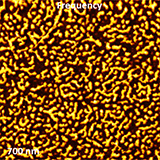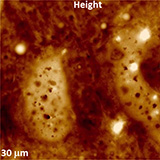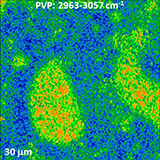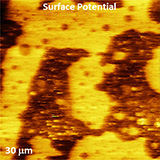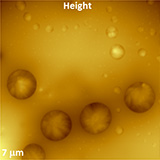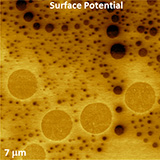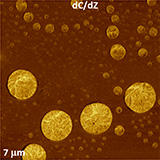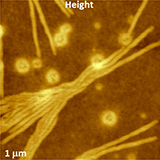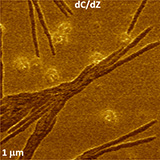NT-MDT in the USA. News Letter # 8, November 2015
30.11.2015
 Printable version Printable version |
||
| Advancing Atomic Force Microscopy in Its Applications | ||
| Ongoing NT-MDT efforts on development of Atomic Force Microscopy (AFM) instruments and applications have led to the essential broadening the method applicability. We have added the quantitative mapping of mechanical properties in Hybrid mode and a combined use of three resonance oscillatory modes: amplitude modulation with phase and frequency imaging and frequency modulation. The operation of NT-MDT microscopes has been further improved by using them in the temperature stable cabinet that insures quiet and low thermal drift environment – the essential feature for many AFM studies. |
These developments were discussed in recent interview to Azo Nano by Dr. Sergei Magonov.
It was also clearly stated that our immediate goal is to increase researchers’ awareness about the continuously expanding capabilities of our microscopes, and the high quality of the obtained results. These issues will be on “our plate” during the coming exhibition at MRS Fall meeting in Boston. |
|
| Compositional Imaging in AFM | ||||||||||||||
| In addition to the visualization of surface structures with unique resolution and accuracy, AFM provides important capability for distinguishing components of multicomponent materials. This function is realized by observations of specific features of the components and probing different properties of constituents. The main methods for compositional imaging in different AFM modes are shown in Table 1. In the contact mode the differences in the lateral force, which originate from local friction variations, help to recognize the dissimilar regions of heterogeneous samples. In some cases the researchers were anxious to correlate the observed changes to local chemical composition of the material ("chemical force microscopy"). Table 1. Methods for AFM compositional mapping
With the introduction of amplitude modulation (AM) mode and phase imaging, the capabilities of visualization of different components of complex systems were expanded to embrace soft samples. When a sample is examined at high-force level in AM mode the changes of the probe phase with respect to its drive are different at locations that are dissimilar in adhesion, elastic modulus or viscoelastic response. As a result, a contrast of phase images differentiates these components, and, so far, this approach dominates in the AFM compositional mapping. Semi-empirical relations between the phase changes and local stiffness/modulus/adhesion are used for the interpretation as their analysis in terms of specific samples properties is not feasible. New possibility for compositional imaging comes with the use of frequency imaging in similar (but not identical) AM mode, in which the phase is kept at 90 degrees by adjusting the driving frequency to be at the resonance of the interacting probe. This mode, which is illustrated by the above images of triblock copolymer film, is currently at the evaluation stage. |
In some applications it offers novel contrast and enhances compositional imaging. Another expansion of compositional imaging came with the quantitative mapping of elastic modulus and work of adhesion that became available in non-resonant oscillatory Hybrid mode. The verification of the modulus mapping on an expanded set of amorphous and semicrystalline polymers, polymer blends and block copolymers showed a rational match between the modulus values obtained in Hybrid mode and the data obtained in the macroscopic measurements. As in the case of phase imaging the compositional imaging in this mode has been demonstrated with the 10-20 nm resolution. The above described recognition of the individual components is based on the specific structural features and local mechanical probing. The use of local electric and dielectric properties is less common but it definitely has the undiscovered values for various kinds of materials. The differences in surface potential, dielectric response, and conductivity are detected in AFM-based electric modes and the related maps show a distribution of components with variations of polarity, content and strength of dipole moments, doping level and type, a presence of charge and carrier mobility. A couple of practical examples are given below in Cool AFM Images. The techniques for compositional imaging are essentially enriched by combining AFM and chemically-specific Raman mapping. In study of immiscible blend of polyvinylpyrrolidone – PVP and poly(ethylene oxide) – PEO (the images on the left) the Raman map of PVP band shows that this component dominates in the higher domains observed in the height image. Yet, according to the surface potential image the composition map of the surface is different. Also the potential variations (bright regions – PVP) exhibit higher resolution. The large sampling volume of Raman scattering is the possible reason for the observed differences. |
|||||||||||||
PEO-PVP blend
|
||||||||||||||
| MRS Fall Meeting | ||||||||||||
| At the forthcoming MRS Fall meeting in Boston we’ll participate in the Exhibit (Booth 200) with a scanning probe microscope Titanium, the advanced controller and a combined AFM/Raman system based on NTEGRA Solar (NT-MDT) and DXR Raman Microscope (Thermo Fisher). NT-MDT has sponsored Symposium UU—Frontiers in Scanning Probe Microscopy, where two contributions will be made by NT-MDT scientists. |
||||||||||||
Surface features on PVP
|
||||||||||||

